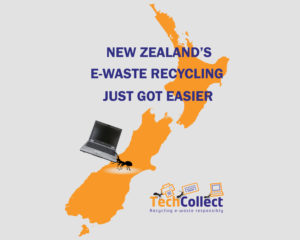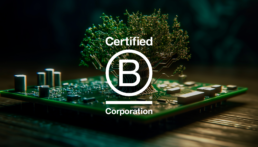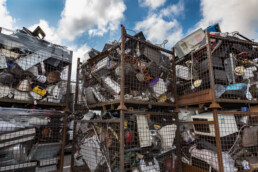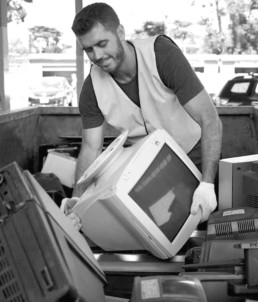New e-waste model: Opportunity to improve?
In July 2023, the Department of Climate Change, Energy and the Environment and Water (DCCEEW) released an e-waste product stewardship discussion paper for public review.
The paper proposes major changes to the policies and regulations that govern e-waste recycling in Australia – particularly the National Television and Computer Recycling Scheme (NTCRS).
The proposed changes will increase the categories of electrical products (e-products) that must be recycled and introduce a single scheme administrator that will oversee the e-waste recycling system. You can read more about what’s changing here.
Positive direction for Australia’s e-waste system
Australia and New Zealand Recycling Platform (ANZRP) supports the government’s proposed changes as a positive step towards a better e-stewardship system. It is a strong sign from government that they are serious about tackling thee-waste issue.
As a not-for-profit organisation that has been a leading e-stewardship service provider for over 12 years, ANZRP has been a strong advocate for improvements to the current model of e-stewardship in Australia and therefore are pleased to see many more categories of e-waste being included in the proposed changes as this will significantly increase the amount of e-waste being recycled.
A greater focus on public awareness and education is also welcomed. Public understanding of the e-waste problem will help ensure that e-products are disposed of properly. It will also help encourage the purchase of more sustainable e-products, providing important market signals to manufacturers and designers.
While we applaud the ambition displayed in the discussion paper, there are still many improvements that government can make before finalising scheme design.
Three areas requiring attention in the government’s proposed new model
ANZRP has been responsible for recycling over 220,000 tonnes of e-waste over a 12 year period of operation. Through this work, ANZRP have helped develop e-waste recycling systems and infrastructure in Australia.
There has been over a decade of learning from industry, government and co-regulatory arrangements, which have become part of the current e-waste model. While we strongly advocate the need for further improvements, it is crucial that past learnings are not ignored.
There are three areas that the government must address in the proposed scheme design.
1 Brand agency is necessary to turn companies from compliers to true stewards of e-products.
Currently, brands are given agency to choose how their e-waste liability is discharged under the NTCRS. Producers and importers of liable products are able to pick between competing co-regulatory arrangements and form a direct relationship to the process of recycling.
This agency gives brands a sense of ownership and responsibility and provides an avenue for them to go above and beyond minimum standards and differentiate themselves.
The proposed changes would see brands simply pay a fixed fee to a scheme administrator to discharge their liability. Tackling e-waste becomes a matter of paying a fee, rather than a meaningful business choice.
By stripping brands of the agency of choosing how their waste is recycled, they are also stripped of the opportunity to be true stewards of their e-products and a continuous improvement focus is lost.
ANZRP proposes that any model the government puts forward incorporates a direct relationship with between brands and network operators (see diagram below).
2. Standards must set a higher bar and provide incentives to go above and beyond; they must also be adequately enforced.
ANZRP has been an advocate for stronger standards in e-waste recycling for many years. The bar is currently set very low, allowing for poor practices across the industry. Additionally, standards are not enforced with enough frequency, meaning that poor practices can continue for a long time, undermining the positive outcomes achieved by others.
The proposed government changes do not make mention of standards and the need to raise and enforce them, which is a key area of omission.
To improve the current system, this is an area that should be a priority. At a minimum, government should set standards of ISO 9001, ISO 45001, ISO 14001 and AS5377 to assure quality environmental outcomes are achieved.
Additionally, these standards must be enforced by the scheme administrator with appropriate frequency to ensure that poor practices cannot go on for too long. Poor practices not only have negative environmental outcomes but also reduce public trust in recycling which impacts the ability to encourage better consumer recycling practices.
There must also be some incentive for companies to go above and beyond the minimum standards and to move beyond simple compliance. The proposed model by government implies that this should be handled by voluntary product stewardship schemes. ANZRP is concerned that relying solely on voluntary schemes to deliver improved standards of recycling will not deliver the required outcomes.
Of concern is that this type of model could lead to a large proliferation of voluntary schemes that could create many different standards that are not harmonised. This would not only add costs for industry but would add costs for government who would need to oversee these different schemes.
3. Remote communities must be treated differently, and there must be local involvement.
ANZRP services some of the most remote communities in Central Australia, the Northern Territory and northern Western Australia. Our experience of providing e-stewardship services to remote communities has shown that it requires a very different approach.
The current model proposed by government does not make a clear statement about how remote communities will be serviced with e-waste recycling services. Volumes from remote communities are extremely low, making recycling far from cost-effective, yet providing access to these communities is critical.
Local involvement and partnerships have been a key part of delivering services and promoting e-waste recycling in these remote communities.
Local councils and community groups also play a large role in e-waste recycling in non-remote areas yet are not featured in the proposed changes. It is not clear how the single scheme administrator will manage these different local groups.
It is critical for any proposed change to articulate the role of local community and government in e-stewardship, as both are key players in the e-waste system.
A pathway to better e-stewardship in Australia
The past 12 years have taught us many lessons about e-waste recycling. It is important for any new model to understand these learnings and build on the foundations of the current system.
By building on what works well now, ANZRP is confident that Australia will be on a pathway to better e-stewardship which supports a rapid transition to a circular economy.
ANZRP recertifies as a B Corp
In July, ANZRP successfully recertified as a B Corp achieving with a score of 109.2, a big improvement on our initial certification score of 89.5 in 2019.
Our commitment to improving our standards of governance, social and environmental wellbeing and employee wellbeing have helped boost our score.
What is B Corp certification?
B Corp (or Benefit Corporation) is a voluntary certification scheme for organisations who aim to demonstrate high standards of social and environmental performance, public transparency, and accountability. Founded in 2006 by B Lab, the B Corp movement aims to use business as a force for good by creating a network of organisations that go beyond profit to benefit people and planet.
Over 7,000 organisations worldwide are certified B Corporations, across 91 countries. Australia is home to 560 of these entities.
Making a huge improvement on our score
To certify, or recertify, a company must complete a B Impact Assessment which will give them a score. The median score for companies who undertake a B Corp assessment is 50.2. To qualify for certification, organisations must score 80 points or above.
We’re proud to have made a massive leap from a score of 89.5 in 2019, to 109.2 this year. It’s hard evidence of the incredible effort that our people have put in over the last few years to improve the way ANZRP runs and grows its positive contribution.

Growing ANZRP’s positive impact – three years of highlights
Since 2019, ANZRP has put in place numerous initiatives to improve its environmental, social and economic performance. Here are some of the achievements we’re proudest of, laid out against B Corp’s five pillars:
Governance –
- Embedding our purpose into our constitution (mission lock) to ensure that our social purpose is legally enshrined.
- Linking social and environmental performance directly to Executive Team roles.
Workers –
- Improving our workplace by establishing hybrid work, expanding our bonus scheme, and providing equitable parental leave.
- Increasing activity of the Wellbeing Team, with double the budget and triple the activity frequency.
- Improvement in employee education, upskilling and on-the-job training.
- Introduction of whistleblower policy.
Community –
- Improved ethnic diversity across the ANZRP team.
- Increased the number of women working at ANZRP to over 50%
- Improved age diversity by 50%.
Environment –
- Increasing our low-impact renewable energy use from 30% to 79% of total energy use.
- Achieving carbon neutrality by tracking carbon emissions and purchasing offsets.
Customers –
- Working with and consulting clients to improve their practices.
- Surveying customers to help measure our outcomes.
- Conducting a third-party Life Cycle Assessment to benchmark our performance.
What next?
ANZRP will next be up for recertification in 2026. By this stage, the format of the assessment will change. The five pillars will become 10, and more questions will be added.
We will continue to build on our success and grow our positive contributions to people and planet.
You can read about our B Corp score in more detail here.
Government to propose changes to e-waste scheme this month
The Department of Climate Change, Energy, the Environment and Water (DCCEEW) is set to release the next e-waste product stewardship discussion paper later this month.
This paper will propose major changes to the policies and regulations that govern e-waste recycling in Australia – particularly the National Television and Computer Recycling Scheme (NTCRS).
These changes will add additional categories of e-waste, more than doubling the amount of e-waste covered by the program, and making many more companies liable for the recycling of their products. This will have a substantial impact on our members and the wider e-waste ecosystem.
ANZRP welcomes the work that the DCCEEW is doing to review and improve the e-waste recycling system. With the right changes, we can better tackle the growing volumes of e-waste in our system.
Reviewing the NTCRS – what’s happening
The Recycling and Waste Reduction Act 2020 (RAWR Act) that governs the NTCRS is being reviewed. Between October 2022 and April 2023, four papers were progressively released for industry consultation on key areas of scheme design. ANZRP engaged government closely on these papers up until the end of the consultation period in April 2023. We have been pleased to have been able to collaborate effectively with government over this period, and hope to see this continue.
The upcoming public consultation paper will present a consolidated version of the proposed changes, reflecting industry’s input. This paper will be released later in June for public consultation over a five-week period before the Department enters into a more detailed design phase.
It is expected that an Exposure Draft will be released at the start of 2024, with new legislation to be enacted by 30 June 2024.
An opportunity to improve the e-waste recycling system – what ANZRP hopes to see
The review of the RAWR Act and the NTCRS presents a huge opportunity for government to improve the way Australia tackles e-waste and shore up some of the gaps in the current system.
As a long-term proponent of higher recycling standards, ANZRP hopes to see the new legislation raise the bar across the industry. At a minimum, the ISO 45001 (safety) and ISO 14001 (environment) standards should be incorporated as appropriate to ensure quality safety and environmental outcomes are achieved.
There is also an opportunity to promote higher levels of recycling performance by tackling compliance as a spectrum rather than a pass/fail. We hope to see a scheme that expects parties to meet a minimum bar, but also rewards those who go above and beyond, providing motivation to strive for higher performance. The scheme should also provide mechanisms to support the improvement of poor performers.
The changes should incorporate stronger oversight of the scheme, with more transparent and regular measurement and reporting of scheme performance from both government and co-regulators. This would also enable more timely administration of the scheme, and reduce the length and impacts of poor performance.
Improvements to the e-waste collection system are also required to ensure fair and equitable provision of collection services in metro, regional and remote locations.
With the expansion of the NTCRS looking to include households and SME e-waste collection, a large-scale public education initiative, as well as consumer resources, will need to be developed to elevate the profile of the scheme and its role in managing Australia’s e-waste. Co-regulators and recyclers should also play a role in public education, with a particular focus on proper recycling processes and safe data deletion.
Lastly, as the broader waste discussion continues to progress towards circularity, ANZRP hopes that the public consultation paper includes considerations beyond recycling. Looking upstream, it will be important to consider the design of products and the right to repair. And looking downstream, factoring in ways to ensure ethical and responsible recycling processes, and production from recovered material.
Taking an ambitious but informed approach
ANZRP has provided e-Stewardship services for over 11 years. Over this time, we have served global technology companies that are leaders in this field. Through the years, we have been strong advocates for higher standards, better quality and more transparency in e-waste recycling.
We support an ambitious approach to tackling e-waste, however one that is well-informed that takes into consideration all the risks to prevent unintended consequences.
The changes to the NTCRS should help upgrade the current system without backtracking on the significant progress that has been made in the last decade.
Provisions will also need to be made to help build capacity within the e-waste recycling sector to handle the higher volumes of waste and prevent build-up of e-waste in storage.
A positive outlook for e-Stewardship
ANZRP has been engaging closely with government on the upcoming changes and have welcomed the level of collaboration and openness during the process. It has given us confidence that the outlook for e-Stewardship in Australia is a positive one. We are hopeful that the next paper will continue this positive trend.
We encourage all our stakeholders to provide their input on the paper when it is made public later this month.
ANZRP achieves its targets two months early
ANZRP has met both its recycling and reasonable access targets for FY23 two months early.
This achievement demonstrates our genuine commitment to meeting our members’ needs and achieving scheme compliance.
Surpassing our targets means that:
- ANZRP can maintain and grow an ‘overcollect’ or buffer of collected material to ensure our members’ obligations are met and provide surety for future years.
- ANZRP is able to make eWaste recycling more inclusive by providing access to more sites across Australia.
We are proud to have achieved our targets early and to grow our contribution to tackling Australia’s growing eWaste challenge.
Recycling more than our share – going beyond our recycling target
The National Television and Computer Recycling Scheme (NTCRS) sets out recycling targets for co-regulators like ANZRP that are increasing each year until 2027 when they reach 80% of available e-waste. The targets ensure that increasing volumes of eWaste are diverted from landfill each year.
In April, we reached our collection target of over 21,900 tonnes, and we will continue to build upon this number as the year continues.
We have achieved this through our established network of council and retail collection sites, supplemented by member collection programs and collections undertaken by our partner recyclers.
ANZRP places stringent requirements on its recyclers, including independent auditing, GPS tracking and weighing to ensure that our recycling numbers are accurate. This means that not only will we have exceeded our recycling target, but we can be confident that our reported figures meet the highest standards of assurance for eWaste recycling.
Meeting our collection target early, and maintaining an over-collect buffer also means that ANZRP can maintain its strict quality standards without fear of missing our targets.
Providing recycling options to Australia’s most remote communities – going beyond our reasonable access target
In addition to the recycling target, the NTRCS sets out a reasonable access target that ensures that all Australians have access to eWaste recycling.
Our partnerships with local councils, community organisations, and businesses like Officeworks have helped meet our reasonable access target in March. The target requires that we provide Australian communities with a population of 2,000 or more with free e-waste collection services through permanent drop-off points and collection events. So far this year, ANZRP has provided over 260 services to Australian communities.
Our dedication to reasonable access goes beyond drop-off services like those at waste transfer stations and retail stores. We also frequently hold collection events in remote communities to encourage eWaste recycling and build communal awareness and understanding of eWaste issues.
While the number of communities that the NTCRS requires we service may change annually, ANZRP remains committed to providing all Australians with access to safe and free disposal of their computers, printers and televisions. This year, we have established a number of new remote sites that we have partnered with local councils and organisations, who we hope to continue working with in years to come.
A recipe for a successful national e-waste recycling program
 As New Zealand considers the benefits of product stewardship and its impact on e-waste recycling, ANZRP CEO Warren Overton sets out the critical elements for a successful national e-waste recycling program based on the Australian experience.
As New Zealand considers the benefits of product stewardship and its impact on e-waste recycling, ANZRP CEO Warren Overton sets out the critical elements for a successful national e-waste recycling program based on the Australian experience.
Last month we launched our TechCollect pilot e-waste recycling program just across the ditch in New Zealand.
Operating through the OfficeMax retail network, TechCollect provides 16 drop-off points across New Zealand where people can take their unwanted e-waste for recycling completely free of charge.
 Already we've had an astounding level of interest, with hundreds of visits to our new website and enquiries rolling in by the dozen. This is indicative of the New Zealand public's appetite for responsible and accessible e-waste recycling, a void that has to this point not been filled. Unlike its Australian and overseas counterparts, the country has struggled to better manage the increasing volume of e-waste generated annually - a recent report from the International Telecommunications Union shows kiwis are among the world's worst offenders, producing an estimated 20kg per person per year.
Already we've had an astounding level of interest, with hundreds of visits to our new website and enquiries rolling in by the dozen. This is indicative of the New Zealand public's appetite for responsible and accessible e-waste recycling, a void that has to this point not been filled. Unlike its Australian and overseas counterparts, the country has struggled to better manage the increasing volume of e-waste generated annually - a recent report from the International Telecommunications Union shows kiwis are among the world's worst offenders, producing an estimated 20kg per person per year.
Product stewardship is key
Australia's approach to managing the growing issue of e-waste is founded on the notion of product stewardship. This concept acknowledges that those involved in producing, selling and using products have a shared responsibility to ensure that those products or materials are managed in a way that reduces their impact, throughout their life cycle, on the environment and on human health and safety.
A key pillar of Australia's National Waste Policy is the Product Stewardship Act 2011. Established under the Act, the National Television and Computer Recycling Scheme (NTCRS) was Australia’s first producer responsibility arrangement. Under the scheme, more than 1,800 collection services have been made available to the public and 230,000 tonnes of TV and computer e-waste collected and recycled. 130,000 tonnes of that has been managed by ANZRP's flagship program TechCollect.
In recent years, the New Zealand Government has twice investigated e-waste product stewardship and on both occasions was unable to establish a long term industry funded program.
Technology industry ready to participate
Despite New Zealand's lack of regulatory enforcement, major players in the electronics industry have just committed to funding our TechCollect pilot e-waste recycling program. Microsoft, Toshiba, HP, Epson, Dell and Canon have all pledged funds to the pilot, which has been a major driver in getting the program off the ground.
The quick commitment from these world-leading organisations shows their eagerness to uphold their corporate social responsibility status, and position themselves as leaders on this issue. They understand the importance of environmental and social sustainability to their brand and are ready with their cheque book to support initiatives that shine a light on their commitment.
Key elements of a successful e-waste recycling program
Fundamental to a thriving e-waste recycling program is a model where industry covers costs of collection and recycling. The ideal approach is through a liability-based fee in a competitive environment that encourages cost competition.
Other critical factors include:
Government funding — Sufficient government funding for e-waste product stewardship is required to ensure effective program management, audit and enforcement of requirements, and promotion of the program to the whole community. Underfunding allows liable parties to avoid compliance and diminishes community engagement with the program.
Competition — Competition is good for logistics and recycling yet is counterproductive for collection as it can create duplication and inefficiencies. Due to the small size of the New Zealand market, the number of organisations engaged to deliver an e-waste product stewardship program should be limited to reduce administrative costs.
Scope — To gain the benefits of scale, for both logistics and processing, as wide a scope as possible is recommended for an e-waste product stewardship program. Under Australia’s NTCRS, only televisions, computers, printers and computer peripherals are accepted. Even though this created a pool of easily identifiable parties, making it easier to manage, inclusion of all waste electronic and electrical equipment (WEEE) would increase the amount of liable parties and exponentially increase the volume targets, guaranteeing greater economies of scale.
Collection network — Vital to its success, a collection network must include a broad spectrum of partners, including local councils, retail providers (such as electrical goods retailers) and private recycling owner-operated sites and community facilities. Aside from maintaining the reach of the service, they also serve an important role helping educate the public through their regular interactions.
Education — It’s important for people to understand the process of recycling e-waste and where they can responsibly dispose of it, knowing that it will be managed to the highest standards in accordance with the regulatory and legislative requirements. To achieve this, a simple and consistent approach is necessary — only government can fill this requirement. After seven years, the Australian public still does not have a strong understanding of e-waste and what can be done. Government needs to take the lead and project clear and consistent messaging.
Recycling partners – Competition is good and should not be limited to a few. Strict standards need to be enforced, ensuring downstream vendor due diligence and material traceability is achieved. All recyclers who serve the program are required to meet certain standards such as compliance to AS/NZS 5377:2013 and HSE legislation, and are regularly audited to ensure reporting volumes are correct.
Now entering its seventh year and despite some issues that need to be ironed out, Australia's NTCRS has been acknowledged as a resounding success. Product stewardship underpinned by accessibility, collaboration, transparency and trust — these are the critical elements that form a successful e-waste recycling program.
ANZRP would welcome the New Zealand Government’s participation into our pilot program, and the prospect of matching program funding to help lengthen and facilitate its ongoing success.
To find out more about our TechCollect pilot in New Zealand go to www.techcollect.nz.
ANZRP meets all FY 16/17 Regulatory targets
ANZRP’s FY 16/17 Annual Report is now published on both the Federal Government and our websites. You can view it here.
We are proud to announce that we have met both Regulatory targets of the National Television and Computer Recycling Scheme (NTCRS) – Recycling and Reasonable Access - and continue to maintain quality standards in a high cost-pressure environment. We also recovered over 95% of the commodities in the e-waste we collected, which is above the Scheme’s Material Recovery Target of 90%.
ANZRP is committed to making an active contribution to the enhancement and progression of product stewardship in Australia; and supporting our Members, not only with their obligations under the NTCRS, but representing them in broader product stewardship and thought leadership activities.
Education is key to driving change, which is why we invest significantly in broad-scale marketing to create community awareness and understanding of the importance of e-waste recycling and to re-evaluate the "take, make and dispose” extractive industrial model.
If you have any questions about the Annual Report, please don’t hesitate to contact us.
5 ways recycling e-waste can benefit your business
An essential part of running a business is to keep up to date with technology, which requires periodically updating your electronic devices. However, the old devices that have been replaced pose a problem for many small businesses — what do you do with the old tech when you replace it?
While throwing old cables and computers out with your general office waste may seem like the easy answer, the better business decision is to responsibly recycle your old or unused electronics.
Recent research commissioned by TechCollect revealed that 83% of Australians weren’t sure where they could recycle e-waste. And 58% said they didn’t want to pay to have devices properly recycled. You’re not alone when it comes to the issue of e-waste in your office; many businesses just aren’t aware of the real benefits of recycling e-waste, or how to start. It’s much easier than you think — here’s what you need to know:
1. Make a positive difference to the environment
The most obvious, yet greatest benefit of recycling e-waste is the positive impact it has on our environment. Many electronic devices contain heavy metals like lead and mercury, which can be extremely harmful to both land and water. Recycling these devices ensures materials don’t end up in landfill, and are instead correctly and safely recovered and recycled.
Electronic devices also contain non-renewable resources, which, if recycled correctly, can be recovered and re-used in the manufacturing of new products. Keeping resources in use is the best outcome and leads to a circular economy.
Recycling is often viewed as a civic duty; however, it is just as important for businesses to consider their environmental impact as part of their daily practice. This is not only beneficial to the environment, but is often expected by consumers, clients and employees.
2. Happy employees
Did you know more than three-quarters of Australian employees want business owners to take more action when it comes to recycling workplace technology?1
With environmental concerns increasing among Australians, employees are beginning to expect recycling e-waste to be common practice in the workplace. In fact, an increasing number of prospective employees are looking to work for businesses that operate under ethical policies and actively make business decisions in which positive environmental outcomes are a priority.
Beyond recruitment, sustainable workplace policies help retain current employees — keeping them happier, productive and more engaged.
3. Improve your brand reputation
Showing your commitment to the environment can strengthen your reputation with current and prospective customers. Recent research shows businesses and brands with a demonstrated commitment to sustainability outperform those who don’t2.
It’s becoming increasingly common to select your business partners based on their ethical standing as organisations. Businesses which actively strive to have a positive impact on the environment make more desirable business partners and a compelling choice for customers. Implementing e-waste recycling is a simple way to enhance your business’s green credentials.
4. Declutter the office
Old and unused electronic devices are often sitting at the back of cupboards gathering dust, or you may even have shelves or the corner of an office dedicated to old technology storage. Not only will recycling your old e-waste benefit the environment — by reducing landfill and the need to mine new resources — but you’ll also have a clean, decluttered office, which ultimately improves efficiency and harmony in the office!
5. Lower business costs
Recycling also has a significant and tangible impact on your bottom line. Did you know that recycling is less expensive than waste removal fees, which are measured by weight?
It is important to choose both a cost-effective and reputable recycling program for your business. Some organisations, including TechCollect, which is dedicated to setting the highest standard of Australian recycling, will collect and recycle your business’s e-waste for free.
What about your data?
Our recent research revealed 52% of Australians are not recycling their IT e-waste due to concerns about security of data.
In fact, personal data was highlighted as a key concern twice, with 64% of respondents also stating they don’t recycle their e-waste because they worry their data will get into the wrong hands. This number has increased by 25% in just two years.
In this technological age, it’s understandable to be concerned about data security and privacy. However, it is relatively simple to permanently remove your data from your company’s electronic devices before they are safely recycled. All you need to do is search online for data wiping services or software, or check with the product manufacturer on how to delete your data. There are also secure commercial services that specialise in data deletion. Be proactive in your data management and don’t let it be a barrier to doing the right thing by the environment!
How do I start?
Below is a simple, step-by-step process to recycle IT e-waste in your office:
- Get the whole team involved.
- Gather all your unwanted and unused IT e-waste from around the workplace.
- Remove your data: search online for data deletion services or software or check with the manufacturer of your product to discover how to delete your data.
- If you have a significant amount of e-waste, call TechCollect on 1300 229 837 to see if your small business qualifies for a free pick-up. TechCollect will take IT and TVs; check out http://techcollect.com.au/what-we-take.
- Or, find your nearest free drop-off point at http://techcollect.com.au/our-locations/. If you can’t find a TechCollect service near you, check out http://recyclingnearyou.com.au.
- Drop off your e-waste, and enjoy your new decluttered office and shining business reputation!
References
1Planet Ark, 2016. National Recycling Week. So You Think You Can Recycle Report, http://recyclingweek.planetark.org/documents/doc-1451-nrw-2016-report-so-you-think-you-can-recycle.pdf
2http://businessrecycling.com.au/research/business-case-competetive-edge.cfm
By Warren Overton, CEO, Australia and New Zealand Recycling Platform
Originally published on Tuesday, 27 February, 2018 by Sustainability Matters
ANZRP launches White Paper at Parliament House
August 2017 marked the launch of ANZRP’s White Paper, which includes many recommended changes to the Product Stewardship Act for consideration during its five-year Regulatory review. On behalf of the Minister for the Environment and Energy, Tim Wilson MP, Federal Member for Goldstein, joined ANZRP’s Chief Executive Officer (CEO) Carmel Dollisson to officially launch the White Paper, which outlines how ANZRP believes the current legislation can be improved to create better recycling practices in Australia.

You can view and download a copy of the White Paper here.
Carmel Dollisson, CEO, ANZRP, explains that ANZRP’s mission has always been to create a community that collects, processes and safely recycles e-waste (electronic waste) for responsible environment outcomes.
“With the changing e-waste landscape, we strongly believe the Review of the Act is key to improving product stewardship in Australia. It is vital for increasing transparency, innovation and economic opportunity in the recycling industry.
“With July marking the sixth anniversary of the Act, we are pleased to have the opportunity to provide an informed industry perspective on how the Scheme is working and ways in which it can be enhanced, updated and improved.
“We have captured the insights of our member companies and our own experience in the White Paper to ensure changes made to the Act deliver the best outcomes for business, local communities and the environment.”
The White Paper details numerous recommendations for the Government Regulator to consider, including:
- Expanding the products collected
- A greater level of shared responsibility by all stakeholders in the product lifecycle
- Greater transparency within the Scheme itself
- Redefining the volume of available e-waste
- Educating the public on the benefits of product stewardship

“The core principle of good product stewardship is that everyone involved in producing, selling, using and disposing of products has a shared responsibility to ensure those products are responsibly recycled.
“That principle has been behind our development of the White Paper. We’re very hopeful that the Review will facilitate greater collaboration and ensure confidence in the e-waste recycling industry.”
To read the White Paper in full, click here.
Regulator publishes 2013/14 reports
The Regulator of the National Television and Computer Recycling Scheme (NTCRS), the Commonwealth Department of the Environment, has just released the Scheme’s 2013/14 Annual Reports for each of the Co-regulatory Arrangements (CAs), as well as its own Outcomes document.
The 2013/14 was a highly successful one for ANZRP and its TechCollect program, in which all regulatory targets were successfully met. We have since just completed our 2014/15 year.
ANZRP’s 2013/14 Annual Report focuses specifically on our work as the largest CA under the Scheme, while the Regulator’s Outcomes document has broader information about the Scheme’s activities.
Minister announces NTCRS changes
Yesterday (10 June) Minister for the Environment Greg Hunt released the outcome of the NTCRS review.
There was some indication that the targets may increase, and this has been reflected in the outcome, with Option 3 (of the different options under consideration) to be adopted.
The key points of the changes are:
- Recycling target to increase in 2015/16 to 50% or an estimated 10,050 additional tonnes – 53,000+ tonnes in total
- Over four years, an additional 32,279 tonnes of e-waste to be recycled
- Product weight conversion factors to be “fairer and more affordable” for liable parties, saving $71M over next the next 10 years
- The Australian Standard will be mandated, however recyclers will have until 1 July 2016 to become certified to the standard
The Minister acknowledged “the vital role of the television and computer industries in funding the scheme”.
ANZRP will issue further information and feedback about the announcement in due course.









